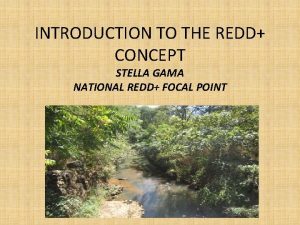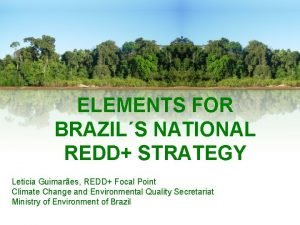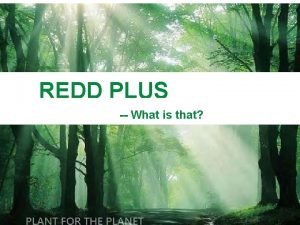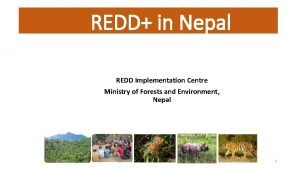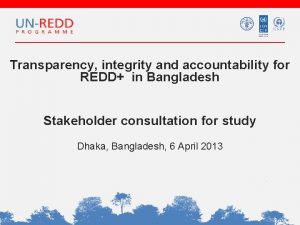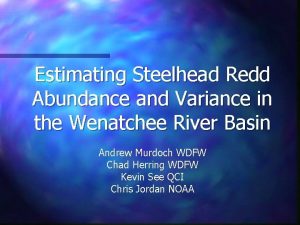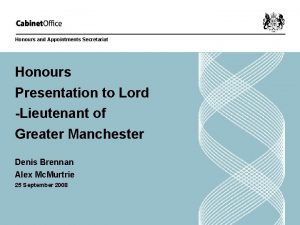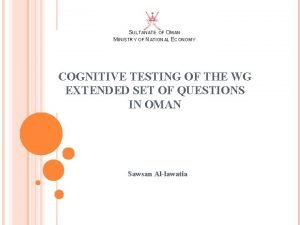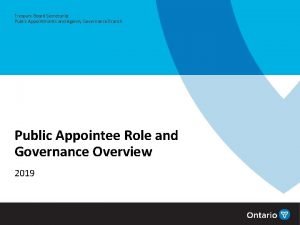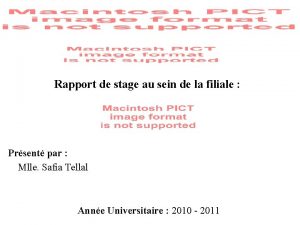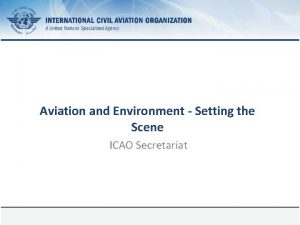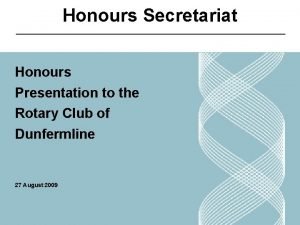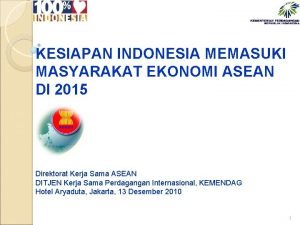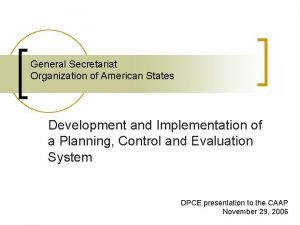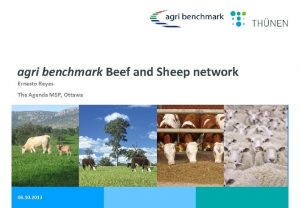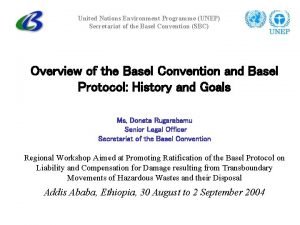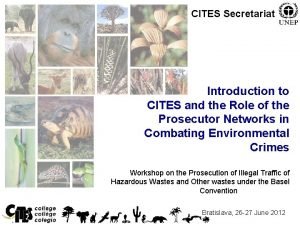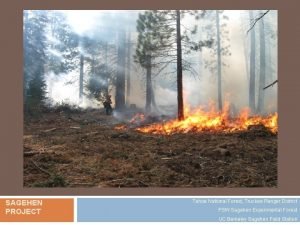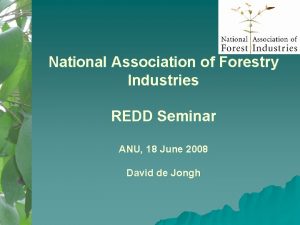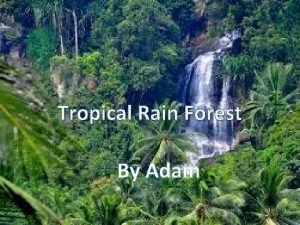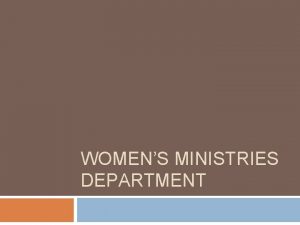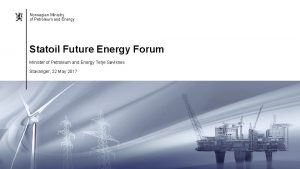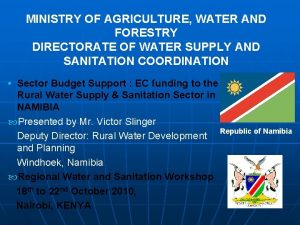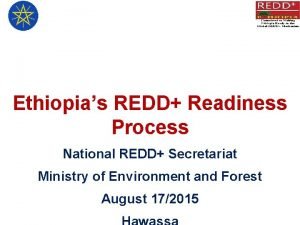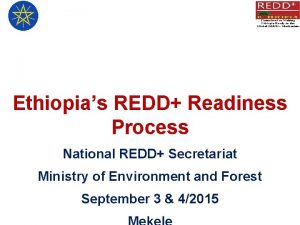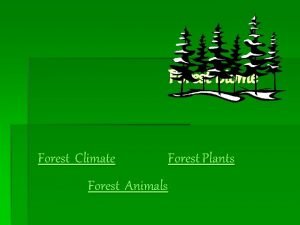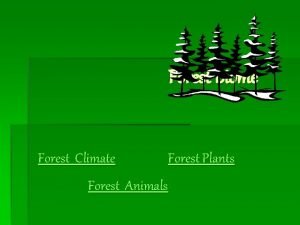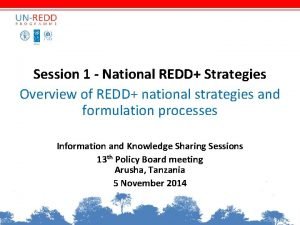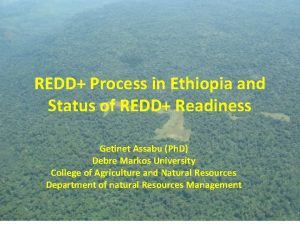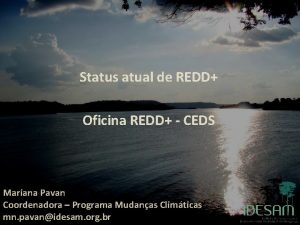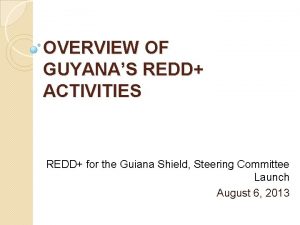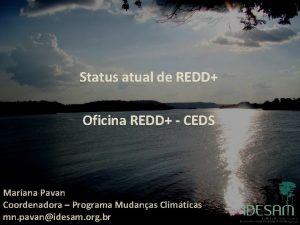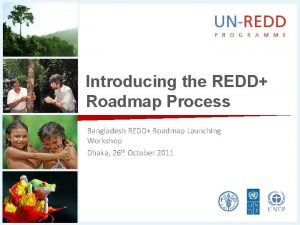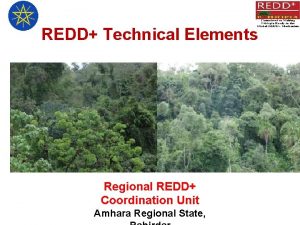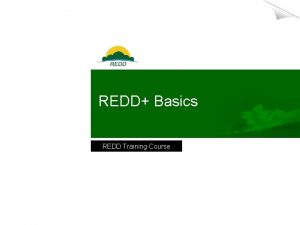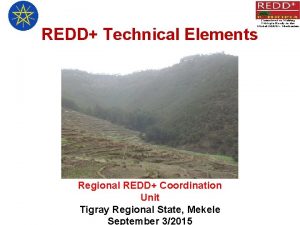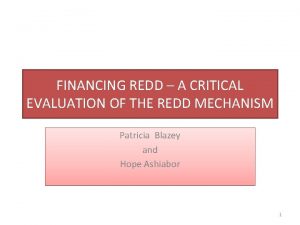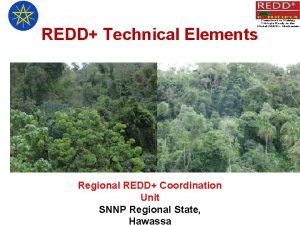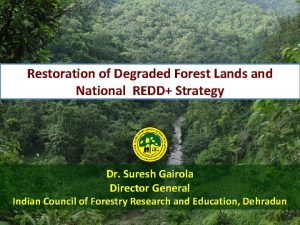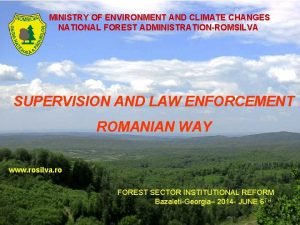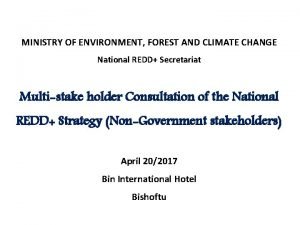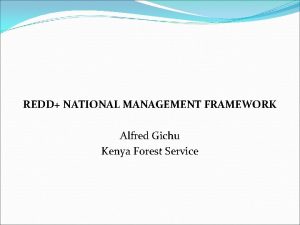MINISTRY OF ENVIRONMENT AND FOREST NATIONAL REDD SECRETARIAT









































- Slides: 41

MINISTRY OF ENVIRONMENT AND FOREST NATIONAL REDD+ SECRETARIAT SNNP Regional REDD+ Coordination Unit Zonal Level REDD+ Awareness Creation Workshop SNNP Regional State, Hawassa August 17/2015 Contact us @ reddplusethiopia@gmail. com

Overview of Regional Awareness Creation Workshop Purpose of the Zonal Workshop Raising stakeholder awareness on REDD+ Basics, Status of REDD+ Readiness Process in Ethiopia and Regional Piloting activity plan Expected Outcomes Workshop participants will be fully aware of the rationale, principles and mechanisms of REDD+, the status of REDD+ Readiness in Ethiopia & planned regional Piloting reddplusethiopia@gmail. com

Climate change & the Role of Forests to Climate Change What are the signs that climate change is occurring? What causes climate change? What is the role of forests in climate change? REDD+ Brief history of REDD+ reddplusethiopia@gmail. com

What is Climate Change? What are the signs of Climate Change? reddplusethiopia@gmail. com

What is Climate Change? • Climate Change = significant change in measures of climate (such as temperature or precipitation) lasting for an extended period of time (typically decades) • United Nations Forum Convention on Climate Change (UNFCCC) defines Climate Change as ‘a change of climate which is attributed directly or indirectly to human activity that alters the composition of the global atmosphere’ reddplusethiopia@gmail. com

Climate Change is happening Four major independent datasets show: 2013 was among the warmest years on record (2 nd to 6 th)

Climate Change is happening Global National

Climate Change is happening Greenhouse gases continued to climb: Atmospheric CO 2 concentration hit a global average of 395. 3 ppm for the year 2013

Climate is happening Changes. Change in precipitation patterns Less rain More rain http: //maps. grida. no/go/graphic/precipitation_changes_trends_over_land_from_1900_to_2000 reddplusethiopia@gmail. com

Rising sea levels + 3. 1 mm per year http: //maps. grida. no/go/graphic/trends-in-sea-level-1870 -2006 Global mean sea level rise from 1870 - 2006 • Sea levels are rising due to thermal expansion and melting glaciers and ice caps • Average global sea levels have risen 17 cm during 20 th century and may rise 28 -58 cm by 2100 reddplusethiopia@gmail. com

More extreme weather events Severe droughts and heat waves Stronger storms Heavy rains reddplusethiopia@gmail. com

Examples of potential impacts § Forest fire incidence 2008 There are reports that fire has affected more than 200, 000 ha every year in recent decades.

Decreasing snow cover and melting glaciers Kilimanjaro 1993 Decreasing snow cover Kilimanjaro 2000 http: //www. mounteverest. net/news. php? id=1361 reddplusethiopia@gmail. com

Warming of poles and loss of sea ice Collapse of Wilkins Ice Shelf, Antarctica reddplusethiopia@gmail. com

What causes climate change and where are greenhouse gas emissions occurring? reddplusethiopia@gmail. com

What human activities generate GHGs? Greenhouse Gas Industrial Sources Carbon dioxide (CO 2) fossil fuel combustion and cement manufacturing Deforestation and burning of forests Methane (CH 4) Landfills, coal mining, natural gas production Conversion of wetlands Rice paddies Livestock production Nitrous oxide (N 2 O) Fossil fuel combustion Nitric acid production Fertilizer use Burning of biomass Hydrofluorocarbons (HFCs) Industrial processes Manufacturing --- Perfluorocarbons (PFCs) Industrial processes Manufacturing --- Sulphur hexafluoride (SF 6) ---- Electrical transmission and distribution systems Land Use Sources

Which sectors produce greenhouse gases? reddplusethiopia@gmail. com

Which Sectors Produce Greenhouse Gasses in Ethiopia? reddplusethiopia@gmail. com

Where are greenhouse gases being emitted? Low emissions High emissions reddplusethiopia@gmail. com

Sources of emissions The sources of emissions differ across developing versus developed countries Greatest source of GHG = fossil fuels Land use change (deforestation) is a major source (second only to fossil fuels) reddplusethiopia@gmail. com

Forests in the global carbon cycle reddplusethiopia@gmail. com

Forests Store and Emit Carbon Deforestation & degradation of forests emit 5. 87 gigatons of carbon dioxide equivalent Forests & other terrestrial systems - absorb 9. 53 gigatons of carbon dioxide equivalent reddplusethiopia@gmail. com

Extent of forests globally 30% of earth’s land surface is forest (4 billion hectares) Forest area by biome Area forest cover Tropical Temperate Boreal reddplusethiopia@gmail. com 16~17 M km 2 9~10 M km 2 15~16 M km 2

Forest carbon globally 45% of terrestrial carbon is stored in earth’s forests Carbon stock by biome % terrestrial C Tropical ~25% Temperate ~10% Boreal ~5% • Forests absorb 2. 6 gigatons C (9. 5 g. T CO 2) per year • Emissions from tropical deforestation 1. 5 gigatons C per year reddplusethiopia@gmail. com

Climate change mitigation through forestry reddplusethiopia@gmail. com

Options for mitigating climate change Increasing carbon sinks Avoiding reducing sinks Ecosystem service: carbon sequestration Mitigation Activities Reducing emissions from productive activities Bioenergy and biofuels reddplusethiopia@gmail. com Ecosystem service: emissions reduction

Quiz Carbon stock Match each carbon stock graph with its description to the right. Carbon stock 1 4 Years Carbon stock Non-forested land Years Carbon stock 2 5 Years Carbon stock 3 Years Forest conversion to non-forested land use Unsustainably managed forest Plantation established on non-forested land harvested regularly Forest converted to a Plantation 6 Years Conserved primary forest

Comparing scenarios For climate change mitigation, which is the best alternative? • A degraded pasture (A) • A forest plantation that is destroyed or burned regularly (B) Carbon A Carbon Years B Years

Answer: B Additional stored carbon in alternative B compared to A = carbon that does not contribute to climate change (even if it is temporary) Carbon § Mean of B § Mean of A Years

Undisturbed forests • An undisturbed forest: – A large stock – But not a large sink Carbon • +/- equilibrium (climax) • Even if an undisturbed forest does not absorb Gh. G from the atmosphere, it is better to conserve it than to convert it to other uses Years

Comparing scenarios For climate change mitigation, which is the better alternative? • Conserving an undisturbed forest (A) • Converting this forest to forest plantation (B)? Carbon A Carbon Years B Years

Answer: A Carbon emitted into the atmosphere under scenario B compared with A = Carbon that Carbon contributes to climate change Years

A brief history of REDD reddplusethiopia@gmail. com

A brief history of REDD • Early 1990 s: Deforestation 1/5 of GHG emissions • 2001 - COP 7: Avoided deforestation was too difficult to include in CDM (+ no additionality). Only A/R • 2005 – COP 11: 2 year consultation period for RED • 2006: Stern report says REDD is big & cheap (& easy? ) 34

What is REDD+ all about? REDD+: Policy approaches & incentive mechanism REDD+ implementation requires enabling Policy framework Legal & regulatory framework Institutional arrangements Full & Effective stakeholder Consultation & participation Technical capacity Investment (Finance)

The Core Idea of REDD+ reddplusethiopia@gmail. com

Phased approach for REDD+ Meridian (2009) & COP 16 (UNFCCC 2010) Phase 1 – the readiness phase focuses on the • development of national strategies or action plans, policies and measures, capacity building and demonstration activities. Phase 2 – Implementation phase focuses on • National policy reforms; intervention measures, as well as on demonstration activities that use results based payment mechanisms.

Phased approaches for REDD+ • Phase 3 – transitioning into Phase 3 will involve moving to more direct results-based actions, i. e. emissions and removals that should be fully measured, reported and verified, with payments based on these results.


What is causing climate change? The natural greenhouse effect Some energy is reflected back into space Solar energy from the sun passes through the atmosphere Greenhouse Gases (GHGs) trap some of the heat, warming the earth GHGs Earth’s surface is heated by the sun and radiates out heat back towards space

The enhanced greenhouse effect Less infrared radiation (heat) escapes to space Higher levels of GHGs trap more heat in atmosphere, leading to temperature increases GHG GHGs GHG
 Stella.redd
Stella.redd Leticia redd
Leticia redd Fiorela shalsi
Fiorela shalsi Redd plus
Redd plus Redd
Redd Carrie mae weems biography
Carrie mae weems biography Redd barna nettvett
Redd barna nettvett Redd cht
Redd cht Steelhead redd
Steelhead redd Honours and appointments secretariat
Honours and appointments secretariat Literacy and numeracy secretariat
Literacy and numeracy secretariat Institute of secretariat training and management
Institute of secretariat training and management Ministry of national education morocco
Ministry of national education morocco Ministry of national economy oman
Ministry of national economy oman Ministry of national education romania
Ministry of national education romania Ministry of national development planning indonesia
Ministry of national development planning indonesia Public appointments secretariat
Public appointments secretariat Exemple de rapport de stage ofppt
Exemple de rapport de stage ofppt Cg digital secretariat
Cg digital secretariat Secretariat scene
Secretariat scene Honours secretariat
Honours secretariat Secretariat family tree
Secretariat family tree Pacific island forum secretariat
Pacific island forum secretariat Asean secretariat
Asean secretariat General secretariat for development planning
General secretariat for development planning International meat secretariat
International meat secretariat Unep secretariat
Unep secretariat Trans kalahari corridor secretariat
Trans kalahari corridor secretariat Cites secretariat
Cites secretariat Environment of business finance
Environment of business finance Truckee ranger station
Truckee ranger station Anu
Anu El yunque national forest animals
El yunque national forest animals El yunque food web
El yunque food web National unification and the national state
National unification and the national state Women's ministry goals and objectives
Women's ministry goals and objectives Women's ministry goals and objectives
Women's ministry goals and objectives Ministry of education romania
Ministry of education romania Statoil
Statoil Orient east med corridor
Orient east med corridor Ministry of agriculture, water and forestry directorates
Ministry of agriculture, water and forestry directorates Seattle university school of theology and ministry
Seattle university school of theology and ministry
